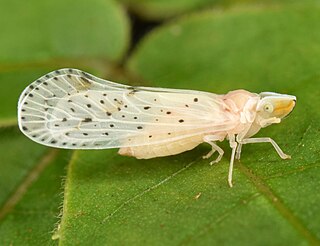
Delphacidae is a family of planthoppers containing about 2000 species, distributed worldwide. Delphacids are separated from other "hoppers" by the prominent spur on the tibia of the hindleg.

The family Derbidae is a large and diverse group of planthoppers, widely distributed in the tropics and also found in subtropical and temperate regions. It includes more than 150 genera and more than 1500 species. The adults suck the sap of plants while the nymphs live mainly in decaying organic matter, for example under the bark of dead tree trunks, feeding on fungi. In some groups of species the general structure of the insects is largely uniform, whereas in others like in the subfamily Otiocerinae various forms can be found. For example, the shape of the head, the antennae or the wings can differ considerably among genera and species.

Acanalonia is a genus of planthopper and contains the majority of the species within the family Acanaloniidae. Species have been recorded from southern Europe and the Americas.

Flatidae are a family of fulgoroid planthoppers. They are cosmopolitan in distribution and are distinguished from others in the superfamily by a combination of characters. Like all other planthoppers, they suck phloem sap of plants. Some species are known to communicate with vibrations through the plant stems. Communication may be with mates, or with ants that tend the nymphs, protecting them and gathering honeydew secretions. Adults of some species have brightly coloured forewings which are tougher and known as tegmina unlike the membranous hindwings which are used for flight. Although a few can be identified by their coloration, most species requires dissection and examination under a microscope with access to literature on already described species.
Tumidagena minuta is a species of delphacid planthopper in the family Delphacidae. It is found in North America.

Delphacinae is a subfamily of delphacid planthoppers in the family Delphacidae. There are at least 1,700 described species in Delphacinae.
Javesella atrata is a species of delphacid planthopper in the family Delphacidae. It is found in North America.

Javesella is a genus of delphacid planthoppers in the family Delphacidae. There are at least 20 described species in Javesella.

Stobaera is a genus of delphacid planthoppers in the family Delphacidae. There are about 14 described species in Stobaera.
Tumidagena is a genus of delphacid planthoppers in the family Delphacidae. There are at least three described species in Tumidagena.

Nothodelphax is a genus of delphacid planthoppers in the family Delphacidae. There are more than 20 described species in Nothodelphax.

Achilidae is a family of planthoppers, sometimes called "achilids" in the order Hemiptera. There are at least 520 described species in Achilidae.
Pentagramma is a genus of delphacid planthoppers in the family Delphacidae. There are about nine described species in Pentagramma.

Asiracinae is a subfamily of delphacid planthoppers in the family Delphacidae. There are at least 30 genera and 180 described species in Asiracinae, which probably has a world-wide distribution.

Sogatella is a genus of delphacid planthoppers in the family Delphacidae. There are more than 20 described species in Sogatella.

Cenchreini is a tribe of derbid planthoppers in the family Derbidae. There are at least 30 genera in Cenchreini.

Derbinae is a subfamily of derbid planthoppers in the family Derbidae.

Dictyopharinae is a subfamily of dictyopharid planthoppers in the family Dictyopharidae. There more than 100 genera and 500 described species in Dictyopharinae.

The Flatinae are a subfamily of planthoppers, erected by Maximilian Spinola in 1839. Genera have been recorded from all continents except Antarctica: especially in tropical and subtropical regions.

Zoraida is a large genus of planthoppers from the family Derbidae, tribe Zoraidini, with more than 100 species. These are widely distributed in the Old World tropics and in some subtropical parts of eastern Asia. In Africa, they are found mainly in the humid tropics of West Africa like Sierra Leone, the Ivory Coast, the Central African Republic, Nigeria or the Democratic Republic of Congo. However, Zoraida species have been also described from eastern Africa as far north as South Sudan and as far south as parts of South Africa. In Asia, the largest number of species have been described/reported from Indonesia, the Philippines, Taiwan and Sri Lanka, but species are also known as far south as northern Australia and as far north as the southern tip of far-eastern Russia. Like other species of the tribe Zoraidini, Zoraida species have long and narrow forewings and short hind wings. They can be identifies by the forewing venation and the structure of the head.














